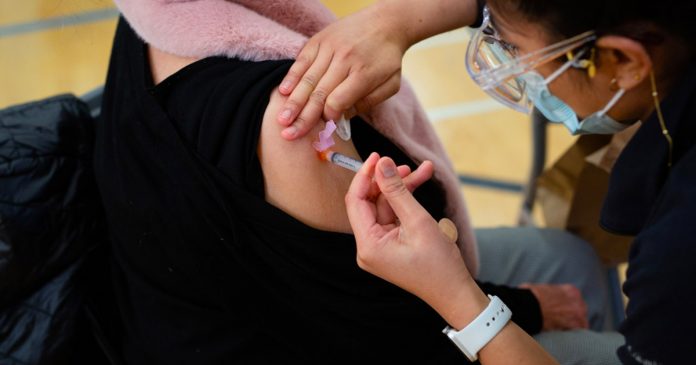Ralph Behrens is a medical doctor in British Columbia. He is an affiliate of the Canadian Society for Science and Ethics in Medicine in collaboration with Healthcare Workers United.
A recent article published in the Canadian Medical Association Journal (CMAJ) titled “Impact of population mixing between vaccinated and unvaccinated subpopulations on infectious disease dynamics: implications for SARS-CoV-2 transmission” has garnered much medical and societal attention.
The article uses unproven and subjective mathematical models in an attempt to simulate one’s COVID-19 infection risk across various patterns of interactions with both vaccinated and vaccine-free individuals.
The author concludes that individuals who avoid vaccination contribute to negative health consequences for others. “The risk of infection [is] markedly higher among unvaccinated people than among vaccinated people under all [population interaction] assumptions.”
Such an assertion is incorrect and blatantly biased, as we will demonstrate.
This article is fraught with egregious misassumptions and glaring omissions. This deceptive study:
● Uses problematic mathematical modeling as a surrogate for real-world data
● Overestimates vaccine effectiveness against symptomatic infection
● Overestimates the risk of transmission (secondary attack rate)
● Underestimates the percentage of the unvaccinated population with effective and robust natural immunity
● Does not account for the waning immunity provided by vaccines
● Is published by a lead author whose conflicts of interest are multiple and significant as it pertains to COVID-19 vaccines.
First, inaccurate mathematical modeling (aka computer modeling) has been frequently used throughout the COVID-19 response in order to justify lockdown measures while promoting unscientific public health edicts. We have yet to observe any real accuracy or public health benefit to the multiple computer modeled declarations or the policies they generate to date.
Next, the authors have used the fictitious range of vaccine effectiveness against symptomatic infection of 40-80%. This represents the upper bound limit of 80% as seen in some Delta variant data and a lower bound limit of 40%, the rate presumed months prior to any real-world early Omicron variant data.
These assumptions are not consistent with the current data available to the medical community. The vaccine effectiveness against Omicron symptomatic infection ranges from 0% to 75% which represents a range independently associated with one’s vaccine type, duration since primary series, and duration since booster(s).
Regarding transmission; the author overstates the ability of vaccines to reduce the risk of transmission of the SARS-CoV-2 virus by a remarkable amount. The most current information available from the publication “United Kingdom COVID-19 Vaccine Surveillance Report Week 16 (April 21st, 2022)” confirms a vaccine effectiveness of 0-25% in reducing SARS-CoV-2 transmission at all time periods since a booster dose. Current data supports the fact that COVID-19 vaccines do a poor job at reducing one’s risk of transmission of disease.
Thus, the authors’ models grossly overestimate vaccine effectiveness against both symptomatic infection and transmission. Moreover, the model proposed fails to account for the single-handedly most important reason for the ongoing and relentless Omicron waves, namely waning vaccine immunity.
Countless studies and real-world data demonstrate rapid waning immunity in the fully vaccinated population. Vaccines do not currently protect the vaccinated. Why can’t we all just admit this reality?
Furthermore, the authors assume a baseline previously infected rate of 20% in the unvaccinated population. Since the Omicron BA.1 and BA.2 waves, it is now estimated that 50-80% of Canadians have been infected and thus have achieved natural immunity, with that number continuing to rise daily.
The longevity of protection from natural immunity against symptomatic infection has been repeatedly proven superior to vaccination alone, meaning that the underestimation of those with natural immunity further skews the model from being anything remotely resembling what we are witnessing in reality.
Since the beginning of the SARS-CoV-2 pandemic, the level of academic rigour, integrity, and quality used to support mandates, restrictions, and Public Health guidance has drastically diminished. We are forced to adhere to observational data and models which would fail scrutiny in any first-year medical epidemiology course as the gold standards for determining efficacy and effectiveness.
Appallingly, this same evidence is being used to guide and dictate policies, which have caused irreversible damage to adolescents, families, careers, and our healthcare system. Randomized control trials are compromised and left unfinished leading to a discreet lack of data that should cause any clinician worth their degree cause for concern.
Finally, we must address the footnote provided in the study. Dr. Fisman admits that he accepts direct compensation from multiple COVID-19 vaccine agencies including Pfizer and AstraZeneca. When it comes to subjective societal models, how can we trust a researcher who has direct financial ties to the vaccine industry to be objective about a matter of utmost financial importance to the companies to which he pledges allegiance? Cui bono?
Evidence-based medicine has lost its aptitude amidst a time where academics like Dr. Fisman financially benefit by producing poor quality studies that the Media, the BC Provincial government and their enablers including the Provincial Heath Officer (PHO) deem as gospel.
The honourable John Horgan recently posed the question “[Do] you want a headline, or do you want action?”. True academics would like quality evidence from independent researchers who have no conflicts of interest.
Unfortunately, the true nature of our current reality leads us to a realm that includes unproven mathematical models, a misunderstanding about the importance of the variables at hand, an underrepresentation of the natural immunity we all share, and most importantly the intentional misleading of the public when it comes to public health matters nation-wide.
Promotion of poorly constructed research such as this can only lead to further stigmatization and division in our once tolerant society. We challenge the CMAJ to retract this “study” and similarly challenge all media outlets who carried this story to issue a correction in their next publication.
This article was first published on KelownaNow.
